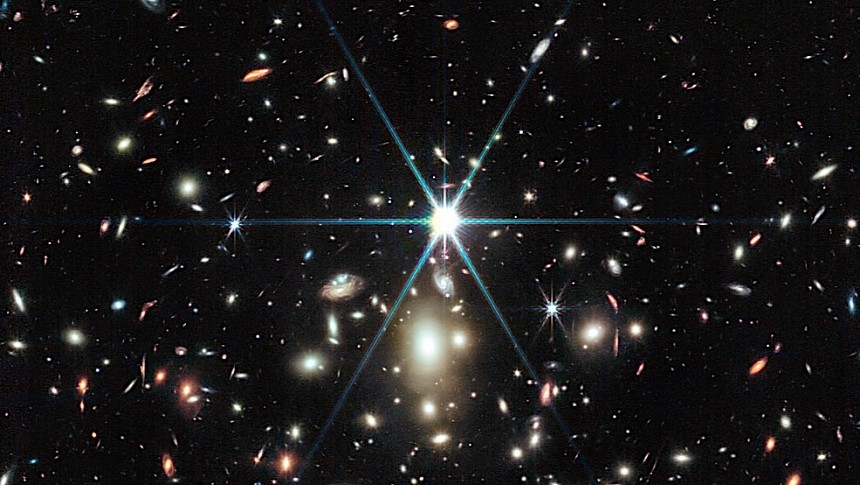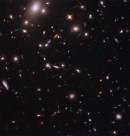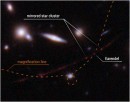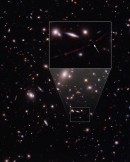No matter if you're into fantasy movies and books or not, there's a good chance the name Earendel rings a bell or two. That's because it's hard to contain the reach and fame of the Lord of the Rings universe, of which Earendel (spelled Earendil) was part.
In the J. R. R. Tolkien stories the character, whose name was probably inspired by an old English word for morning star, was a child of Men and Elves, a seafarer by trade, and carrier of a very shiny jewel called Silmaril on his… brow. For some reason, the character in turn inspired astronomers to name the most distant star that we know of after him.
Earendel the star was spotted by the Hubble Space Telescope back in 2022. Officially called WHL0137-LS, it now shines its light at a comoving distance of 28 billion light-years away from Earth. That's a distance so vast in both space and time that is almost impossible for us to comprehend, and it also means the light Hubble detected from this star comes from 12 billion years in the past, from just 900 million years after the Big Bang.
Now that a more potent telescope is in space, the James Webb, astronomers had another look at the star, and this time the images reveal more exciting details about the star, but also the place's colors.
First up, the star's location. Earendel sits in a region of the sky called the WHL0137-08 galaxy cluster, in a galaxy called the Sunrise Arc. The cluster is so massive that it "warps the fabric of space itself." In doing so, it creates a magnifying effect, a phenomenon astronomers call gravitational lensing that allows us to see things so distant we would normally not be able to see.
Using gravitational lensing but also Webb's Near-Infrared Camera, astronomers were able to determine Earendel is a B-type star, meaning extremely bright and giving out a blue light. In the case of this particular star, we're talking about luminosity a million times greater than our own Sun, coming from a surface that's twice as hot (Sun's surface temperature is almost 5,500 degrees Celsius/9,930 degrees Fahrenheit).
As you can see in the main photo of this piece, Earendel showed Webb some of its colors, especially that blue tint clearly visible among the red and white of the surrounding stars. The colors of the region have astronomers believe that, as often is the case with stars of this kind, a smaller, redder star is probably accompanying the huge bright monster.
As for the region Earendel is located in, it may still be around. Sure, the things we're looking at in the Webb pic are billions of years old, but because the cluster is gravitationally bound, the formations seen there have a big chance of still being around.
We'll definitely know that billions of years from now, when the light emitted today reaches us.
Earendel the star was spotted by the Hubble Space Telescope back in 2022. Officially called WHL0137-LS, it now shines its light at a comoving distance of 28 billion light-years away from Earth. That's a distance so vast in both space and time that is almost impossible for us to comprehend, and it also means the light Hubble detected from this star comes from 12 billion years in the past, from just 900 million years after the Big Bang.
Now that a more potent telescope is in space, the James Webb, astronomers had another look at the star, and this time the images reveal more exciting details about the star, but also the place's colors.
First up, the star's location. Earendel sits in a region of the sky called the WHL0137-08 galaxy cluster, in a galaxy called the Sunrise Arc. The cluster is so massive that it "warps the fabric of space itself." In doing so, it creates a magnifying effect, a phenomenon astronomers call gravitational lensing that allows us to see things so distant we would normally not be able to see.
Using gravitational lensing but also Webb's Near-Infrared Camera, astronomers were able to determine Earendel is a B-type star, meaning extremely bright and giving out a blue light. In the case of this particular star, we're talking about luminosity a million times greater than our own Sun, coming from a surface that's twice as hot (Sun's surface temperature is almost 5,500 degrees Celsius/9,930 degrees Fahrenheit).
As you can see in the main photo of this piece, Earendel showed Webb some of its colors, especially that blue tint clearly visible among the red and white of the surrounding stars. The colors of the region have astronomers believe that, as often is the case with stars of this kind, a smaller, redder star is probably accompanying the huge bright monster.
As for the region Earendel is located in, it may still be around. Sure, the things we're looking at in the Webb pic are billions of years old, but because the cluster is gravitationally bound, the formations seen there have a big chance of still being around.
We'll definitely know that billions of years from now, when the light emitted today reaches us.







